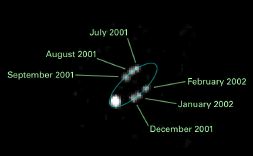

|
Документ взят из кэша поисковой машины. Адрес
оригинального документа
: http://www.stsci.edu/~inr/thisweek1/2009/thisweek012.html
Дата изменения: Sat Jan 31 00:00:01 2009 Дата индексирования: Sun Apr 5 21:54:21 2009 Кодировка: Поисковые слова: uv |


| Program Number | Principal Investigator | Program Title | Links |
| 11113 | Keith S. Noll, Space Telescope Science Institute | Binaries in the Kuiper Belt: Probes of Solar System Formation and Evolution | Abstract |
| 11130 | Luis Ho, Carnegie Institution of Washington | AGNs with Intermediate-mass Black Holes: Testing the Black Hole-Bulge Paradigm, Part II | Abstract |
| 11230 | Christopher P. O'Dea, Rochester Institute of Technology | HST FUV Observations of Brightest Cluster Galaxies: The Role of Star Formation in Cooling Flows and BCG Evolution | Abstract |
| 11236 | Harry Teplitz, California Institute of Technology | Did Rare, Large Escape-Fraction Galaxies Reionize the Universe? | Abstract |
| 11564 | David L. Kaplan, Massachusetts Institute of Tech | Optical and Ultraviolet Photometry of Isolated Neutron Stars | Abstract |
| 11612 | Kris Davidson, University of Minnesota - Twin Cities | Eta Carinae's Continuing Instability and Recovery - the 2009 Event | Abstract |
| 11944 | Douglas R. Gies, Georgia State University Research Foundation | Binaries at the Extremes of the H-R Diagram | Abstract |
| 11956 | Keith Noll, Space Telescope Science Institute | Hubble Heritage: Side B | Abstract |
| 11962 | Adam Riess, The Johns Hopkins University | A New Supernova in the Antennae; Narrowing in on the Hubble Constant and Dark Energy | Abstract |
| 11966 | Michael W. Regan, Space Telescope Science Institute | The Recent Star Formation History of SINGS Galaxies | Abstract |
| 11968 | Howard Bond, Space Telescope Science Institute | The Light Echoes around V838 Monocerotis: Cycle 16 DD | Abstract |
GO 11113: Binaries in the Kuiper Belt: Probes of Solar System Formation and Evolution
 A composite of HST images of the Kuiper Belt binary, WW31
A composite of HST images of the Kuiper Belt binary, WW31
|
The Kuiper Belt consists of icy planetoids that orbit the Sun within a broad band stretching from Neptune's orbit (~30 AU) to distance sof ~50 AU from the Sun (see David Jewitt's Kuiper Belt page for details). Over 500 KBOs are currently known out of a population of perhaps 70,000 objects with diameters exceeding 100 km. Approximately 2% of the known KBOs are binary (including Pluto, one of the largest known KBOs, regardless of whether one considers it a planet or not). This is a surprisingly high fraction, given the difficulties involved in forming such systems and the relative ease with which they can be disrupted. It remains unclear whether these systems formed from single KBOs (through collisions or 3-body interactions) as the Kuiper Belt and the Solar System have evolved, or whether they represent the final tail of an initial (much larger) population of primordial binaries. This proposal will use WFPC2 imaging of known KBOs to identify new binary systems. |
GO 11564: Optical and Ultraviolet Photometry of Isolated Neutron Stars
GO 11966:
The Recent Star Formation History of SINGS Galaxies